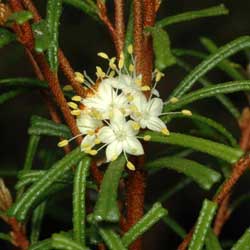Federation Flower for Tasmania
Phebalium daviesii (St Helens Wax Flower)
Species of flower, whether native and its conservation status
Phebalium daviesii only occurs in Tasmania and is restricted to a small area on the banks of the George River in the north-eastern Tasmania. The species was last collected in 1892 had been considered extinct until being rediscovered by fern expert Mike Garrett in 1990. It is currently listed as an endangered species. [photo]
 Appearance of flower
Appearance of flower
The flowers appear at the ends of the branches in clusters of 6 -8 and while each individual flower is small the shrub generally flowers profusely so that the whole plant is covered in flowers. The flowers can be a light to deep cream colour. (click right image to enlarge)
Appearance of the leaves
The leaves of this species are 2-3 cm long and wedge shaped. They are green above and covered with silver hairs on the underside. The leaves are relatively tightly packed on the stems and this feature of the plant together with its attractive leaves will make it useful all year round in the florist industry and as a potential foliage plant.
Appearance and length of the stem
The young branches are clothed in brown scales and have a dusky appearance. The branch stems would be suitable to cut to a length of 45 cm for use in florist's bouquets.
Height of grown plant
Phebalium daviesii is a small shrub that grows to a height of 1 -1.5 m and has a width of 0.6-1.5 m.
Flowering period
The flowering period extends from September to November and single plants will hold their flowers over a period of 4 - 6 weeks.
Floricultural potential, horticultural potential, mass production
The species can be propagated readily from cuttings, could be mass produced and grown in the ground and has some potential as a foliage plant for the florist industry. The plant is currently propagated locally in several native plant nurseries and is being planted in home gardens.
Preferred habitat for cultivation
Phebalium daviesii grows in the wild on the banks of a river above the waterline in a free draining granite sand in an open forest community. In cultivation the plant would be favoured by a protected, sunny to semi-shaded position in freely draining acidic soil with a moderate amount of watering. It is able to withstand moderate frosts. Regular light pruning will help to create a well shaped plant.
Propagation methods
a) The species strikes readily from cuttings but no success has
been achieved from seed.
b) Cuttings can be taken most of the year if propagation occurs under glass.
Cuttings have been taken successfully at the RTBG in January, April, May, November
and December with a strike rate of about 60%.
c) Seed germination has been poor with no germinants 5 months after sowing in
a 50/50 sphagnum moss and sand mix with bottom heat.
d) Cuttings can be ready to pot up in tubes after 2 moths in and 6" pots
after 6 months.
e) Semi-hardwood lateral cuttings are best taken at 7 - 10 cm in length.
f) No information is available on the time taken to produce a plant from seed.
Life of the flower once cut
No information is available on the life of the cut flower but as the plant holds it's flowers for 4 - 6 weeks it is likely that the flowers will last for up to 2 weeks as a florists specimen. Foliage can be used all year round and should have a good vase life.
Endangered Species Status
More information (with photo and distribution map) on its status as an endangered species from the Tasmanian Parks and Wildlife Service.
Information supplied by Mark Fountain - Royal Tasmanian Botanical Gardens
![An Australian Government Initiative [logo]](/images/austgovt_brown_90px.gif)








